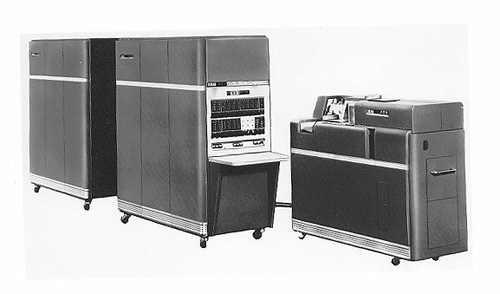
IBM 650
Until the new computing center building to house the large mainframe computer was completed, WDPC operated an IBM 650 computer and auxiliary punch card equipment. The equipment was delivered in April, 1957 and housed in a large room in the BAE building (now DODD Hall) that had been the statistics laboratory. The 650 replaced the Marchant and Friden calculators that students used for projects in the stat courses. The 650 remained here until August, 1958, when it was moved into the newly completed WDPC building and then later removed entirely
The IBM 650 was a magnetic drum memory machine with 2000 words of storage. It was a decimal machine, not binary, and each word contained 10 decimal digits and a sign. Instructions operated on numbers stored in this format. Each word could hold 10 digits of data, or 5 alphabetic characters, or one instruction. Initially, both Input and output were from punch cards. The output cards were then listed on an IBM 407 accounting machine where dollar signs and decimal points could be added. Later, magnetic tape units and line printers were added.
The 650 was programmed using an assembler language, SOAP (for Symbolic Optimal Assembly Program) and later SOAP II, an improved version. With it, input was from punch cards and output could be to a printer.
A FORTRAN compiler (FORTRANSIT) became available that compiled the FORTRAN statements into SOAP. You ran a FORTRAN job by first punching your FORTRAN program on cards using a key punch machine, along with your data and control cards. To compile the program, you fed a FORTRAN compiler deck of cards into the card reader followed by your program as data. The 650 then punched your object deck (your program coded to run on the machine). Then, you fed a FORTRAN run-time library object deck and your program's object deck into the card reader. Your program ran and your results punched on yet another deck of cards that would be listed on an IBM 407 accounting machine so that you could read the results printed on paper.
The 650 could calculate approximately:
78,000 additions or subtactions per minute,
5,000 multiplications per minute,
3,700 divisions per minute,
138,000 logical decisions per minute,
if optimally programmed.
Although IBM called it an automatic calculator, it was a true general- purpose computer, perhaps the first IBM commercial business computer. IBM was surprised by the demand for the machine. It was relatively cheap and relatively small so that it would fit into one room. It also had a console with lots of bllinking lights so that the user could tell that something was going on. And, it was friendly enough that the users (students and faculty) could operate the machine themselves "hands on." For this reason alone, it was a superb first machine for WDPC.
PHOTO IBM 650

Photo held in IBM Archives